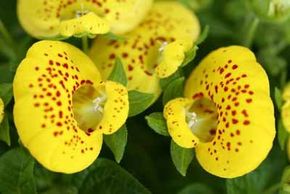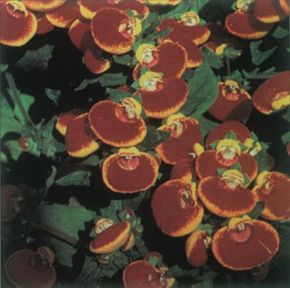The pocketbook plant's unique blossom shape, resembling a little pouch, is the origin of both the common name and the botanical name of this plant. In Latin, calceolus means "slipper."
Annuals Image Gallery
Description of pocketbook plant: Flowers appear like clusters of small grapes, although they're held upright rather than trailing and cover the foliage when in full bloom. In their preferred cool climates, they bloom all summer but can be used for fall, winter, and spring bloom in frost-free areas. Their ultimate height is 8 to 12 inches by 10 inches wide.
Advertisement
Growing pocketbook plant: Pocketbook plant grows best in moist soil with partial protection from intense summer sun. For spring and fail use, full sun will increase flowering. To induce repeat flowering, cut back plants when blossoms fade.
Propagating pocketbook plant: Start new plants by seeds or by cuttings. Sow seeds 6 to 8 weeks prior to last frost without covering. They germinate in 8 to 18 days at 60 degrees Fahrenheit. They may also be sown outdoors. Seedlings must be thinned to 6 inches apart.
Uses for pocketbook plant: Plant them near water -- by stream banks, at pool edges, or near bogs and moist woodlands in partial shade. So long as their roots are kept moist, they will also make good container plants.
Pocketbook plant related species: Good for the partially shaded rock garden is Calceolaria falklandia, a dwarf, tufted native of the Falkland Islands with purple spotted, primrose-yellow flowers. It survives winter only in frost-free gardens. Calceolaria mexicana is an annual with typical yellow flowers that bloom all summer.
Pocketbook plant related varieties: Goldcrest, Golden Bunch, and Midas are all sunshine-yellow in color. Goldcrest has larger flowers than the others. Bubblegum mix has large flowers in a range of oranges.
Scientific name of pocketbook plant: Calceolaria herbeofruticosa
Pocketbook plant's beautiful flowers can also brighten up your home, although not for a prolonged period of time. Go to the next page to learn about pocketbook as a house plant.
Want more information? Try these:
- Annual Flowers: Discover your favorite annual flowers. We've organized them by color, sunlight, soil type, and height to make it easy to plan your garden.
- Annuals: There's more to an annuals garden than flowers. Learn about all of the annuals that enhance your garden.
- Perennial Flowers: Complement your annuals with these delightful perennial flowers. They are also organized by height, soil type, sunlight, and color.
Advertisement

